Location: Cold Bay, Alaska (& Izembek Lagoon)
Dates: August 23~Dec. 15 every year.
2025 Dates
•Aug.23-29 (6 spots; $5,000 p/p); ($5,500 p/p for the following)…Aug.30-Sep.5 (5 spots); Sep.6-26 (full); Sep.27-Oct.3 (6 spots); Oct.4-10 (full); Oct.11-17 (2 spots); Oct.18-Dec.15 (full)
•We are taking 50% deposits for 2025
Species
Pacific black brant, emperor geese, cacklers, Taverner’s geese, Pacific common eider, harlequin, long-tail duck, common goldeneye, greater scaup, red breasted merganser, black scoter, white-wing scoter, bufflehead, pintail, mallard, wigeon, green-wing teal and occasional surprise species like Aleutian green-wing teal, Eurasian wigeon, king eider and more. Also, willow ptarmigan and silver salmon.
Cost
•September-October hunts, $5,500 per person, 5 hunting days, Sat.-Friday (up to 10 people).
•November-December hunts, $5,900 per person, 6 hunting days, Sat.-Sat. (up to 8 people).
NOTE: All packages include lodging, meals, guides, bird cleaning & storage. Not included are license, stamps and tips.
- Pacific Common Eider
- Glass Floats
- Emperor Geese
- Banded Black Brant
- Harlys & Scoter
Overview
The world’s best waterfowl hunting is found right here, in Alaska’s Cold Bay and Izembek Lagook. From early season hunts in September, to late season trophy hunts for some of the world’s most prized sea ducks and geese, hunting from land and boats is the norm. All hunting is done over decoys with the outfitter, himself.
Duck & Goose Hunting In Cold Bay, Alaska
We’ve hunted with this outfitter multiple times, both in Cold Bay, Alaska and on St. Paul Island, Alaska. We’ve taken prized king and common eider with him, multiple species of sea ducks and puddle ducks, as well as emperor geese, Pacific black brant, and more. He’s one of the most knowledgable outfitters and hunters we’ve been in the field with, and is a certified captain to run in the open ocean and bays of Alaska. His passion for waterfowl hunting is contagious, making this one of the best hunts we have to offer.
Alaska’s waterfowl season opens September 1, and hunting this time of year is done from shore, typically off points of land extending into shallow water where decoys and layout boats are situated. Hunters can also sit on shore, hunting from the comfort of firm ground during the early season hunts in September and October.
 During the early season, hunters can expect lots of shooting action, as the puddle duck limit is 8 a day (24 in
During the early season, hunters can expect lots of shooting action, as the puddle duck limit is 8 a day (24 in  possession), black brant 2 a day (6 in possession, cacklers 6 a day (18 in possession), 10 ptarmigan a day, plus you can keep five silver salmon a day. September is prime time for a cast and blast, with fresh, great eating coho salmon pouring into the many small streams in the area. Willow ptarmigan can also be hunted if populations are strong.
possession), black brant 2 a day (6 in possession, cacklers 6 a day (18 in possession), 10 ptarmigan a day, plus you can keep five silver salmon a day. September is prime time for a cast and blast, with fresh, great eating coho salmon pouring into the many small streams in the area. Willow ptarmigan can also be hunted if populations are strong.
October is a month of transition, as more sea ducks arrive in the area. By late October good numbers of harlequin ducks as well as black scoter and white-wing scoter arrive in the bays. Black brant numbers continue building by the thousands, with exceptional hunting from layout boats in Izembek Lagoon, taking place. Cacklers are still around, as they typically start their journey south in early November.
 In November and through mid-December, black brant, Pacific common eider and sea ducks are the focus of the hunts. Harlequins, long-tails, common goldeneye, bufflehead, greater scaup, black scoter, white-wing scoter and red breasted mergansers are all regulars, with common eider and black brant being the most sought after by serious waterfowl hunters. The occasional king eider is also taken this time of year.
In November and through mid-December, black brant, Pacific common eider and sea ducks are the focus of the hunts. Harlequins, long-tails, common goldeneye, bufflehead, greater scaup, black scoter, white-wing scoter and red breasted mergansers are all regulars, with common eider and black brant being the most sought after by serious waterfowl hunters. The occasional king eider is also taken this time of year.

If the weather is bad during these late season hunts and you can’t get into Cold Bay (on the Pacific Ocean side), there are options. You can move inland and hunt ponds for puddle ducks that may still be around, look for protected places in Izembek Lagoon (on the Bering Sea side) in which to hunt brant and sea ducks, hit the tundra in pursuit of willow ptarmigan, or head to the beach in search of antique glass floats, a highly prized bonus many hunters desire.
On a recent December hunt to this camp, we experience two days of winds in excess of 60 mph, and couldn’t get out to hunt. Instead, our group of hunters turned the focus to glass float searching on multiple beaches, and came away with over 800 of the gems!
 This is also the best place in the world to hunt highly prized emperor geese. In 2017, the first emperor goose season was open to Alaska residents for the first time in over 30 years. In 2018, there’s a limited draw for 25 lucky non-residents. There are multiple options when it comes to hunting these coveted geese in either Cold Bay, or Izembek Lagoon, and our outfitter is dialed-in to all possibilities.
This is also the best place in the world to hunt highly prized emperor geese. In 2017, the first emperor goose season was open to Alaska residents for the first time in over 30 years. In 2018, there’s a limited draw for 25 lucky non-residents. There are multiple options when it comes to hunting these coveted geese in either Cold Bay, or Izembek Lagoon, and our outfitter is dialed-in to all possibilities.
In late November of 2017 I accompanied two hunters on their emperor goose quest in Cold Bay. Having these majestic birds cup into the decoys is an image I never thought I’d live to see. Holding these striking birds, snapping photo after photo, is something I’ll never forget.
There’s a small, though well stocked store in Cold Bay, where you can pick up beverages and additional snacks you might desire. A visit to the Izembek National Wildlife Refuge is worth a couple hours of your time, too.

Tag & License Costs
•$60.00 nonresident small game hunting license
•$10.00 Alaska duck stamp
•$25.00 Federal duck stamp
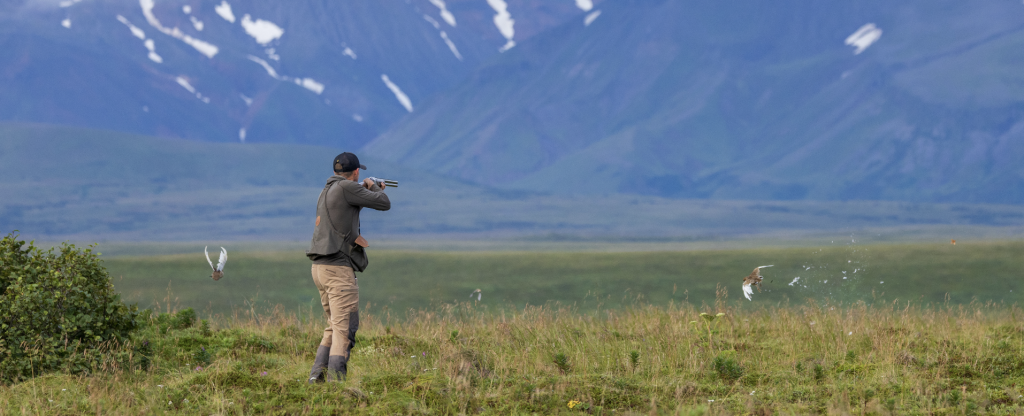
CAST & BLAST COMBINATIONS
While this is largely an elite waterfowl hunting destination, the coho fishing and willow ptarmigan hunting can be exceptional around Cold Bay and Izembek Lagoon. Willow ptarmigan season opens on August 10th in this part of Alaska. The daily bag limit is 10 birds. Because willow ptarmigan populations can be cyclical based on winter survival rates, it’s not always a guaranteed hunt. The past few seasons have been solid, though, with willow ptarmigan numbers growing. Hunts for willow ptarmigan are a bonus in conjunction with the waterfowl hunting and coho fishing around Cold Bay, so the intent is not to shoot limits of ptarmigan every day of your stay.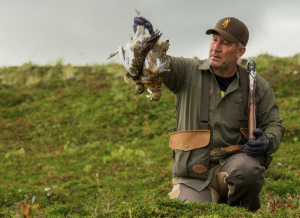
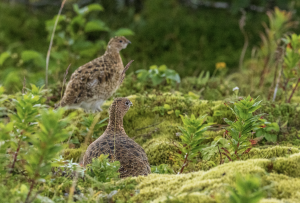 Willow ptarmigan hunting is done by hiking off roads or following boat rides across various bays and Izembek Lagoon. Leather hiking boots that are waterproof are best for covering ground. The tundra here can be challenging to negotiate, so the better shape you’re in, the more ground you can cover, the better chance there is of getting on willow ptarmigan. Because willow ptarmigan hunting takes place in the refuge, nontoxic shotgun shells are required.
Willow ptarmigan hunting is done by hiking off roads or following boat rides across various bays and Izembek Lagoon. Leather hiking boots that are waterproof are best for covering ground. The tundra here can be challenging to negotiate, so the better shape you’re in, the more ground you can cover, the better chance there is of getting on willow ptarmigan. Because willow ptarmigan hunting takes place in the refuge, nontoxic shotgun shells are required.
Family flocks of willow ptarmigan are the norm early in the fall. By mid-October the willow ptarmigan are starting to turn white and the flocks are getting bigger as family groups combine. By late November most ptarmigan are fully plumed in all white feathers. A number of hunters like shooting one or two of these specimens to have mounted.
The coho fishing around Cold Bay continues to be some of the best on the Alaska Peninsula in recent years. While other coho fisheries up and down the Peninsula have struggled, the coho salmon fishing in small streams to the north and south of Cold Bay has been very good. Of all the places I’ve fished for coho in Alaska over the past 30+ years, this area yields the biggest size average I’ve personally experienced.
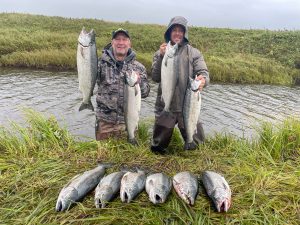 Many waterfowl hunters are now planning their trips around the coho runs, preferring to take home 50 pounds of salmon fillets over waterfowl. They’ll eat the birds they shoot while in camp, then take home fish. Coho fishing starts getting good around August 20, and limits for everyone is typical into early October. Because the streams here are very small and so close to the ocean, the coho are big, fat, and delicious. Some serious salmon anglers are discovering just how good the coho fishing is here, and going to do nothing but fish.
Many waterfowl hunters are now planning their trips around the coho runs, preferring to take home 50 pounds of salmon fillets over waterfowl. They’ll eat the birds they shoot while in camp, then take home fish. Coho fishing starts getting good around August 20, and limits for everyone is typical into early October. Because the streams here are very small and so close to the ocean, the coho are big, fat, and delicious. Some serious salmon anglers are discovering just how good the coho fishing is here, and going to do nothing but fish.
The coho streams are small and simple to wade and fish. Your duck waders will suffice. The lodge has basic coho fishing gear,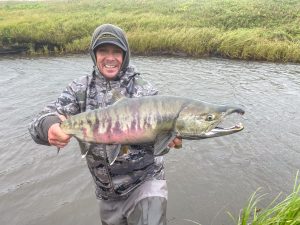 and they cure eggs to be fished with as bait. Serious anglers like bringing their own gear. Bobber and jigs, bobber and bait, spinners, lures and Mag Lips are among the best coho catching gear I’ve used here. The flyfishing for coho can be exceptional with small, pink patterns, being best. Have a selection of weighted flies should the water be high. A floating line is all you need as the streams are shallow. Chum salmon and Dolly Varden are also abundant.
and they cure eggs to be fished with as bait. Serious anglers like bringing their own gear. Bobber and jigs, bobber and bait, spinners, lures and Mag Lips are among the best coho catching gear I’ve used here. The flyfishing for coho can be exceptional with small, pink patterns, being best. Have a selection of weighted flies should the water be high. A floating line is all you need as the streams are shallow. Chum salmon and Dolly Varden are also abundant.
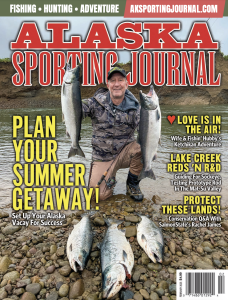
Travel Planning
Hunters fly to Cold Bay, Alaska, where the outfitter will personally meet you and take you to the lodge. After arriving in Anchorage, Alaska, take the escalator downstairs to the Pen Air terminal. Here you’ll check in, weigh your carry-on bags, and board the twin engine prop’ plane for the flight to Cold Bay. At the end of the hunt, you and your bags will be taken to the airport for the flight home. Hunters must know this is very remote and weather can sometimes cause a change in flight plans, so be patient and enjoy the journey.
- Cold Bay, Alaska









